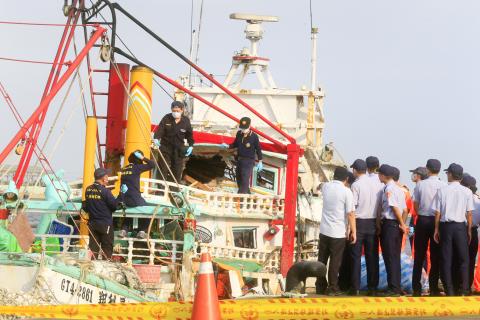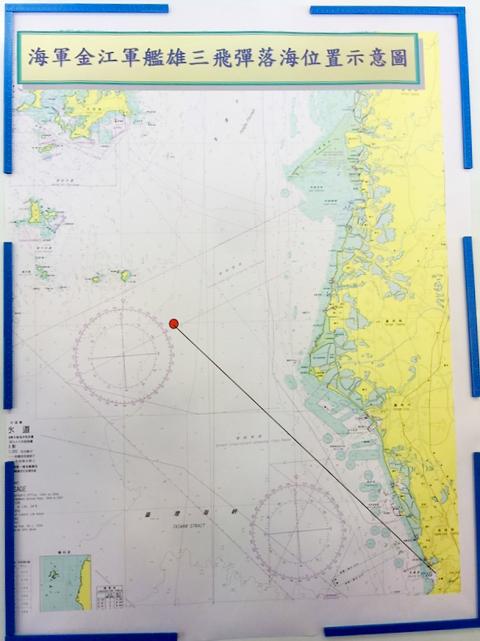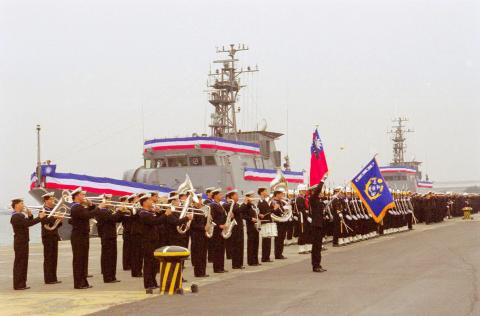One fisherman was killed and three injured after a locally developed supersonic anti-ship missile was launched from one of the navy’s 500-tonne corvettes docked at Zuoying (左營) Military Harbor in Kaohsiung at 8:15am yesterday, the navy said.
The Hsiung Feng III missile did not cross the median line of the Taiwan Strait, it said, adding that the firing was most likely caused by human error.
At a news conference called in the wake of the incident, Navy Command Headquarters chief of staff Vice Admiral Mei Chia-shu (梅家樹) said the corvette was taking part in an exercise at the base when the missile was launched by mistake.

Photo: CNA
The missile fell into waters near Penghu County about 40 nautical miles (74.1km) northwest of the base more than two minutes after its launch during an exercise, Mei said, adding the missile fell into waters on the Taiwan side of the median line.
The Taiwan Strait has an average width of 180km.
A chart provided by the navy showed that the simulated target was in the Taiwan Strait, northwest of the harbor and southeast of the offshore county of Penghu.

Photo: Screengrab by Huang Chien-hua, courtesy of the ROC Navy
Mei said that after the incident, the navy sent a helicopter to the area to make sure the missile had not caused any harm, adding that other navy vessels were also dispatched to the area to help with the search.
Following an initial report that there was an “explosion” on a fishing boat in the Taiwan Strait at about the same time as the missile incident, it was later confirmed that a Taiwanese fishing boat was hit by the missile, causing the death of its captain and injuring the three others on the boat.
In a statement, the Ministry of National Defense said that Chief of General Staff Yen De-fa (嚴德發) was leading a task force to conduct further investigation into the incident.

Photo: CNA, courtesy of the Ministry of National Defense
Minister of National Defense Feng Shih-kuan (馮世寬) instructed deputy chiefs of general staff to head to an emergency center to deal with follow-up issues immediately after the incident occurred, it added.
“Initial information showed that the operator[s] did not follow standard procedure” for testing military equipment during a drill, Mei said.
Mei declined to answer questions about the standard operating procedure for the simulation of a Hsiung Feng III missile launch, saying he could not disclose classified information.

Photo: CNA
The locally developed Hsiung Feng III missile reportedly has a range of up to 300km.
Mei said a non-commissioned officer should have been familiar with the procedures involved in the missile exercise, but further investigation was needed to determine why the missile was fired, he added.
When asked whether the missile might have been launched intentionally, Mei said investigators would look at all possibilities.
He said that yesterday’s exercise was a regular test of military equipment.
The incident occurred as the Chinese Communist Party held an event in Beijing to mark the 95th anniversary of the party’s founding.
Asked whether China took any military action in the wake of the incident, Mei said that the navy did not notice any “abnormal actions” by Chinese military aircraft or vessels.
One report, citing an unnamed navy source, said that radar signals indicated some abnormal activity among Chinese military posts after the missile was launched, but Mei said the report was inaccurate.
Mei said there were no Chinese electronic surveillance ships in the area where the missile landed when asked whether Chinese ships might have been trying to collect military intelligence, such as the missile’s electronic signature.
Mei said that the navy has no direct communication mechanism with China.
The navy passed on information to the National Security Council and other government agencies to deal with follow-up measures, he said.
Presidential Office spokesman Alex Huang (黃重諺) said that President Tsai Ing-wen (蔡英文), who was in Los Angeles on the return leg of a diplomatic trip to Latin America, received a briefing on the incident and that she has asked government agencies to investigate.
The navy yesterday held a third news conference at 7:30pm, with navy Commander Huang Shu-kuang (黃曙光) saying a sergeant did not follow proper procedures in the drill and performed the testing by himself without any supervisors present.
Seven service members, including the sergeant and Huang Shu-kuang, are to be disciplined, said Huang Shu-Kuang, who called the launch a very serious mistake.
Meanwhile, four people involved in the accident, including the sergeant who allegedly launched the missile and the captain of the military vessel, have been taken to the Kaohsiung District Prosecutors’ Office for questioning.

The US government has signed defense cooperation agreements with Japan and the Philippines to boost the deterrence capabilities of countries in the first island chain, a report by the National Security Bureau (NSB) showed. The main countries on the first island chain include the two nations and Taiwan. The bureau is to present the report at a meeting of the legislature’s Foreign Affairs and National Defense Committee tomorrow. The US military has deployed Typhon missile systems to Japan’s Yamaguchi Prefecture and Zambales province in the Philippines during their joint military exercises. It has also installed NMESIS anti-ship systems in Japan’s Okinawa

‘WIN-WIN’: The Philippines, and central and eastern European countries are important potential drone cooperation partners, Minister of Foreign Affairs Lin Chia-lung said Minister of Foreign Affairs Lin Chia-lung (林佳龍) in an interview published yesterday confirmed that there are joint ventures between Taiwan and Poland in the drone industry. Lin made the remark in an exclusive interview with the Chinese-language Liberty Times (the Taipei Times’ sister paper). The government-backed Taiwan Excellence Drone International Business Opportunities Alliance and the Polish Chamber of Unmanned Systems on Wednesday last week signed a memorandum of understanding in Poland to develop a “non-China” supply chain for drones and work together on key technologies. Asked if Taiwan prioritized Poland among central and eastern European countries in drone collaboration, Lin

ON ALERT: Taiwan’s partners would issue warnings if China attempted to use Interpol to target Taiwanese, and the global body has mechanisms to prevent it, an official said China has stationed two to four people specializing in Taiwan affairs at its embassies in several democratic countries to monitor and harass Taiwanese, actions that the host nations would not tolerate, National Security Bureau (NSB) Director-General Tsai Ming-yen (蔡明彥) said yesterday. Tsai made the comments at a meeting of the legislature’s Foreign Affairs and National Defense Committee, which asked him and Minister of National Defense Wellington Koo (顧立雄) to report on potential conflicts in the Taiwan Strait and military preparedness. Democratic Progressive Party (DPP) Legislator Michelle Lin (林楚茵) expressed concern that Beijing has posted personnel from China’s Taiwan Affairs Office to its

BACK TO WORK? Prosecutors said they are considering filing an appeal, while the Hsinchu City Government said it has applied for Ann Kao’s reinstatement as mayor The High Court yesterday found suspended Hsinchu mayor Ann Kao (高虹安) not guilty of embezzling assistant fees, reducing her sentence to six months in prison commutable to a fine from seven years and four months. The verdict acquitted Kao of the corruption charge, but found her guilty of causing a public official to commit document forgery. The High Prosecutors’ Office said it is reviewing the ruling and considering whether to file an appeal. The Taipei District Court in July last year sentenced Kao to seven years and four months in prison, along with a four-year deprivation of civil rights, for contravening the Anti-Corruption